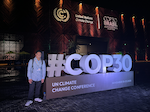

Laura Bergin ’17 had never curated an art exhibition in her life. In fact, she wasn’t even an art history major. Yet that didn’t stop her from proposing and then curating a powerful exhibition on conflict over the course of 10 weeks as an Andrew W. Mellon Foundation Summer Scholar.
“Bodies in Conflict: From Gettysburg to Iraq,” features photographs, scrapbooks, lithographs, and posters from the American Civil War, World War I, World War II, the Vietnam War, and the War in Iraq. It is on display until Oct. 22 in Schmucker Art Gallery.
Bergin always held an interest in photojournalism, art, and museums. But coming to Gettysburg, she wasn’t sure what she wanted to study.
“I heard about the option to design my own major and thought that was a great possibility for me,” said Bergin. In her sophomore year she was approved through the Interdisciplinary Studies program for a self-designed major called “Images of Conflict.” Her major combines classes in journalism; Cinema & Media Studies; Women, Gender, and Sexuality Studies; Globalization Studies; Latin American, Caribbean, and Latino Studies; and Anthropology.
“Through that process I learned to think critically about what I’m truly passionate about and to understand that passion from different perspectives,” said Bergin. “I believe this has made me a much more open-minded person, as I bridge disciplines with differing methodologies and theories each day.”
The exhibition was inspired by a course she took with her advisor, Prof. Amy Evrard, during the fall of her junior year about the anthropology of violence and conflict. That same semester, after a class with Art & Art History Prof. Shannon Egan, director of the Schmucker Art Gallery, Bergin asked if she could create something in the gallery around the topic of conflict.
With Egan’s guidance, she applied for the Mellon Summer Scholarship while studying abroad in Salamanca, Spain. Over the summer, Egan served as Bergin’s faculty mentor for the project.
“I learned an extraordinary amount this past summer in a short time period,” said Bergin. “Prof. Egan constantly pushed me to better myself as a researcher and a scholar. She has been an amazing mentor to me.”
“Bodies in Conflict: From Gettysburg to Iraq” utilizes art & artifacts entirely from Gettysburg College’s Special Collections, including Iraqi artist Wafaa Bilal’s Chair, from The Ashes Series. The piece was acquired through the Michael Birkner ’72 and Robin Wagner Art and Acquisitions Fund, with additional support from The Andrew W. Mellon Foundation for the Middle East and Islamic Studies program at Gettysburg College. Bilal came to campus on Oct. 18 for a gallery talk about his work.
“All of the works in the exhibition reflect American influence, whether they were made by Americans, depict American bodies, or were created in opposition to American influence,” said Bergin.
A challenge for Bergin was creating the catalog and digital version of the exhibition, which includes a virtual walk-through of the show. She researched primary sources from each historical time period, as well as the theories and ethics behind creating representations of the body in conflict.
“It’s a difficult exhibition to see – it’s a sensitive topic,” said Bergin. “I hope when people go to this space, they’ll have intellectual debates about the pieces and think about the reasons why certain artists decided to use that medium, that brush stroke, those colors, or that style, and how it makes the viewer feel.”
 Bergin credits the lessons she’s learned as a student-athlete on the volleyball team to helping her stay organized and proactive. This season she passed a milestone by becoming the 12th member of the 1,000 career kill club at Gettysburg College. She was also named the Centennial Conference Co-Player of the Week in volleyball.
Bergin credits the lessons she’s learned as a student-athlete on the volleyball team to helping her stay organized and proactive. This season she passed a milestone by becoming the 12th member of the 1,000 career kill club at Gettysburg College. She was also named the Centennial Conference Co-Player of the Week in volleyball.
Looking forward, Bergin is keeping her options open. She’s interested in applying for a Fulbright to Chile or Argentina, working in the museum field, and eventually attending graduate school for conflict studies.
“So far, I’ve found many employers are interested and intrigued by the idea of an individual major, setting me apart from others with traditional majors,” said Bergin.



